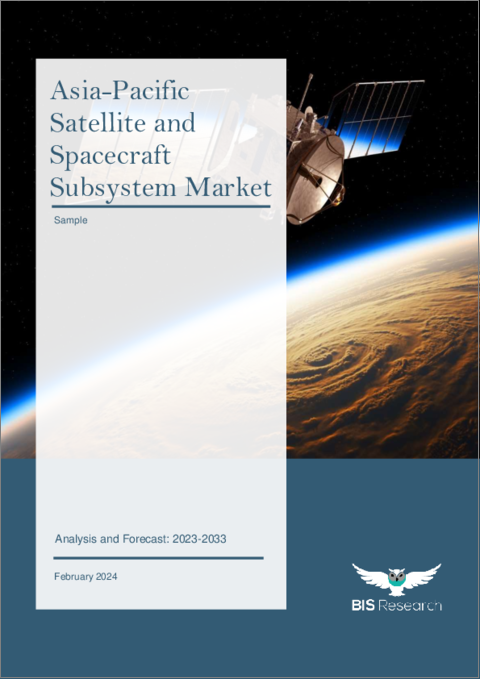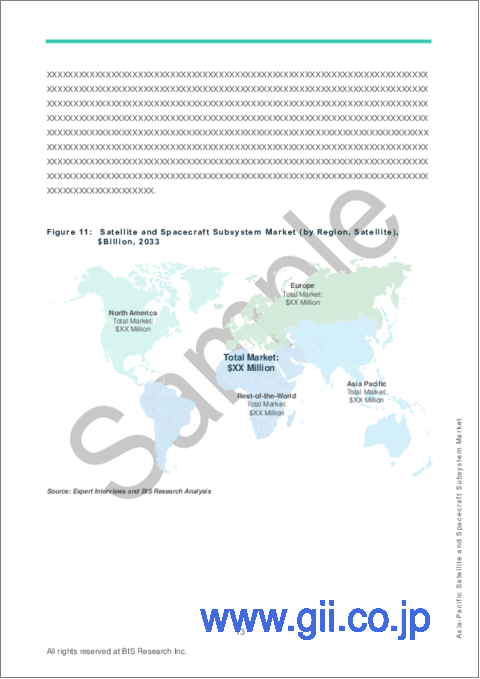|
|
市場調査レポート
商品コード
1450321
アジア太平洋の衛星および宇宙船サブシステム市場:分析・予測 (2023-2033年)Asia-Pacific Satellite and Spacecraft Subsystem Market: Analysis and Forecast, 2023-2033 |
||||||
カスタマイズ可能
|
|||||||
| アジア太平洋の衛星および宇宙船サブシステム市場:分析・予測 (2023-2033年) |
|
出版日: 2024年03月15日
発行: BIS Research
ページ情報: 英文
納期: 1~5営業日
|
全表示
- 概要
- 図表
- 目次
アジア太平洋の衛星および宇宙船サブシステムの市場規模は、2023年の31億2,960万米ドルから、予測期間中は7.29%のCAGRで推移し、2033年には63億2,380万米ドルの規模に成長すると予測されています。
この急成長の主な要因は商業宇宙部門の急成長であり、前例のないレベルの衛星配備と、地球を周回する運用衛星数の著しい急増が見られます。この動向は、同部門の継続的な成長と力強い成長軌道を示しています。
| 主要市場統計 | |
|---|---|
| 予測期間 | 2023-2033年 |
| 2023年評価額 | 31億2,960万米ドル |
| 2033年予測 | 63億2,380万米ドル |
| CAGR | 7.29% |
アジア太平洋地域の衛星および宇宙船サブシステムの市場は、同地域の急成長する宇宙開発イニシアティブと衛星ベースのサービス需要の増加に牽引され、著しい成長を遂げています。中国、インド、日本などの国が宇宙開発計画を拡大する中、先進的な衛星サブシステムの開発が重視されるようになっています。この市場には、推進システム、電力システム、通信システム、ペイロードなど、さまざまな重要コンポーネントが含まれます。この地域の企業は、これらのサブシステムの効率、信頼性、性能を高めるためにR&Dに多額の投資を行っています。さらに、通信、航法、地球観測、リモートセンシングの各用途で衛星技術の採用が増加していることも、市場の成長をさらに後押ししています。アジア太平洋諸国が宇宙探査と衛星技術への投資を続ける中、同地域の衛星および宇宙船サブシステム市場は継続的な成長と技術革新の態勢を整えています。
当レポートでは、アジア太平洋の衛星および宇宙船サブシステムの市場を調査し、市場概要、主要動向、影響因子および機会の分析、市場規模の推移・予測、各種区分・国別の詳細分析、競合情勢、主要企業のプロファイルなどをまとめています。
市場の分類:
セグメンテーション1:エンドユーザー別
- 商業
- 政府
- 防衛
- 学術/研究グループ
セグメンテーション2:衛星サブシステム別
- ペイロード
- 電気・電力サブシステム
- コマンド・データ処理システム
- 通信サブシステム
- 熱制御サブシステム
- 姿勢決定・制御サブシステム
- 推進システム
- メカニズム
- アクチュエータ
- 構造
セグメンテーション3:ロケットサブシステム別
- 構造
- アビオニクス
- 推進システム
- 制御システム
- 電気系統
- ステージ分離
- 熱システム
セグメンテーション4:地域別
- 中国
- インド
- 日本
- その他
目次
エグゼクティブサマリー
第1章 市場
- 業界の展望
- 新たな宇宙事業シナリオ:衛星および宇宙船サブシステム市場の成長要因
- 3Dプリントの影響:宇宙産業の革命
- 宇宙複合材料の変化する情勢
- 衛星の量産におけるCOTSコンポーネントの影響
- サプライチェーン分析
- 事業力学
- 事業促進要因
- 事業上の課題
- 事業戦略
- 企業戦略
- 事業機会
第2章 アジア太平洋
- 衛星および宇宙船サブシステム市場 (地域別)
- アジア太平洋
- 市場
- 用途
- 製品
- アジア太平洋 (国別)
第3章 市場:競合ベンチマーキング・企業プロファイル
- 競合ベンチマーキング
- 企業プロファイル
- Mitsubishi Electric Corporation
第4章 調査手法
List of Figures
- Figure 1: Asia-Pacific Satellite and Spacecraft Subsystem Market (Satellite Subsystem), $Billion, 2022-2033
- Figure 2: Asia-Pacific Satellite and Spacecraft Subsystem Market (Satellite Subsystem), Units, 2022-2033
- Figure 3: Asia-Pacific Satellite and Spacecraft Subsystem Market (Launch Vehicle Subsystem), $Billion, 2022-2033
- Figure 4: Asia-Pacific Satellite and Spacecraft Subsystem Market (Launch Vehicle Subsystem), Units, 2022-2033
- Figure 5: Asia-Pacific Satellite and Spacecraft Subsystem Market (by End User), $Million, 2023 and 2033
- Figure 6: Asia-Pacific Satellite and Spacecraft Subsystem Market (by End User), Units, 2023 and 2033
- Figure 7: Asia-Pacific Satellite and Spacecraft Subsystem Market (by Satellite Subsystem), $Million, 2023 and 2033
- Figure 8: Asia-Pacific Satellite and Spacecraft Subsystem Market (by Satellite Subsystem), Units, 2023 and 2033
- Figure 9: Asia-Pacific Satellite and Spacecraft Subsystem Market (by Launch Vehicle Subsystem), Units, 2023 and 2033
- Figure 10: Asia-Pacific Satellite and Spacecraft Subsystem Market (by Launch Vehicle Subsystem), $Million, 2023 and 2033
- Figure 11: Satellite and Spacecraft Subsystem Market (by Region, Satellite), $Billion, 2033
- Figure 12: Satellite and Spacecraft Subsystem Market (by Region, Launch Vehicle), $Billion, 2033
- Figure 13: Supply Chain Analysis for Satellite and Spacecraft Subsystem Market
- Figure 14: Satellite and Spacecraft Subsystem Market, Business Dynamics
- Figure 15: Share of Key Business Strategies and Developments, January 2020-June 2023
- Figure 16: Satellite and Spacecraft Subsystem Market Players, Benchmarking Score (Satellite), 2022
- Figure 17: Research Methodology
- Figure 18: Top-Down and Bottom-Up Approach
- Figure 19: Assumptions and Limitations
List of Tables
- Table 1: New Product Launches, Developments, and Others, January 2020-June 2023
- Table 2: Partnerships, Collaborations, Agreements, Contracts, and Others, January 2020-June 2023
- Table 3: Mergers and Acquisitions, January 2020-June 2023
- Table 4: Satellite and Spacecraft Subsystem Market (by Region), Satellite Subsystem), Units and $Million, 2022-2033
- Table 5: Satellite and Spacecraft Subsystem Market (by Region, Launch Vehicle),Units and $Million, 2022-2033
- Table 6: Asia-Pacific Satellite and Spacecraft Subsystem Market (by End User), Units and $Million, 2022-2033
- Table 7: Asia-Pacific Satellite and Spacecraft Subsystem Market (by Satellite Subsystem, Units and $Million, 2022-2033
- Table 8: Asia- Pacific Satellite and Spacecraft Subsystem Market (by Launch Vehicle Subsystem), $Million and Units, 2022-2033
- Table 9: China Satellite and Spacecraft Subsystem Market (by End User), Units and $Million, 2022-2033
- Table 10: India Satellite and Spacecraft Subsystem Market (by End User), Units and $Million, 2022-2033
- Table 11: Japan Satellite and Spacecraft Subsystem Market (by End User), Units and $Million, 2022-2033
- Table 12: Rest-of-Asia-Pacific Satellite and Spacecraft Subsystem Market (by End User), Units and $Million, 2022-2033
- Table 13: Benchmarking and Weightage Parameters
- Table 14: Mitsubishi Electric Corporation: Product Portfolio
- Table 15: Mitsubishi Electric Corporation: New Product Developments and Fundings
- Table 16: Mitsubishi Electric Corporation: Partnerships, Collaborations, Contracts, and Agreements
Introduction to Asia-Pacific Satellite and Spacecraft Subsystem Market
The Asia-Pacific satellite and spacecraft subsystem market based on satellite subsystem is estimated to reach $6,323.8 million by 2033 from $3,129.6 million in 2023, at a growth rate of 7.29% during the forecast period 2023-2033. The surge in growth is primarily attributed to the burgeoning commercial space sector, which has seen unprecedented levels of satellite deployments and a marked surge in the total count of operational satellites orbiting the Earth. This trend underscores the sector's ongoing growth and vigorous growth trajectory.
| KEY MARKET STATISTICS | |
|---|---|
| Forecast Period | 2023 - 2033 |
| 2023 Evaluation | $3,129.6 Million |
| 2033 Forecast | $6,323.8 Million |
| CAGR | 7.29% |
Market Introduction
The Asia-Pacific satellite and spacecraft subsystem market has witnessed significant growth, driven by the region's burgeoning space exploration initiatives and increasing demand for satellite-based services. With countries like China, India, and Japan expanding their space programs, there's a growing emphasis on developing advanced satellite subsystems. This market encompasses various critical components such as propulsion systems, power systems, communication systems, and payloads. Companies in the region are investing heavily in research and development to enhance the efficiency, reliability, and performance of these subsystems. Additionally, the rising adoption of satellite technology for communication, navigation, Earth observation, and remote sensing applications further propels market growth. As APAC nations continue to invest in space exploration and satellite technology, the satellite and spacecraft subsystem market in the region is poised for continuous growth and innovation.
Market Segmentation:
Segmentation 1: by End User
- Commercial
- Civil Government
- Defense
- Academic/Research Group
Segmentation 2: by Satellite Subsystem
- Payload
- Electrical and Power Subsystem
- Command and Data Handling System
- Communication Subsystem
- Thermal Control Subsystem
- Attitude Determination and Control Subsystem
- Propulsion System
- Mechanism
- Actuator
- Structure
Segmentation 3: by Launch Vehicle Subsystem
- Structure
- Avionics
- Propulsion System
- Control System
- Electrical System
- Stage Separation
- Thermal System
Segmentation 4: by Region
- China
- India
- Japan
- Rest-of-Asia-Pacific
How can this report add value to an organization?
Product/Innovation Strategy: The product segment helps the reader understand the different types of subsystems available for deployment and their potential. Moreover, the study provides the reader with a detailed understanding of the Asia-Pacific satellite and spacecraft subsystem market based on satellite subsystem, launch vehicle subsystem, and deep space probe subsystem.
Growth/Marketing Strategy: The Asia-Pacific satellite and spacecraft subsystem market has seen major development by key players operating in the market, such as contract, collaboration, and joint venture. The favored strategy for the companies has been contracted to strengthen their position in the satellite and spacecraft subsystem market.
Competitive Strategy: Key players in the Asia-Pacific satellite and spacecraft subsystem market analyzed and profiled in the study involve major satellite and spacecraft subsystem companies providing subsystems, respectively. Moreover, a detailed market share analysis of the players operating in the satellite and spacecraft subsystem market has been done to help the reader understand how players stack against each other, presenting a clear market landscape. Additionally, comprehensive competitive strategies such as partnerships, agreements, and collaborations will aid the reader in understanding the untapped revenue pockets in the market.
Table of Contents
Executive Summary
1 Market
- 1.1 Industry Outlook
- 1.1.1 New Space Business Scenario: A Growth Factor in the Satellite and Spacecraft Subsystem Market
- 1.1.2 Impact of 3D Printing: Revolutionizing Space Industry
- 1.1.3 Changing Landscape of Space Composites
- 1.1.4 Impact of Commercial-Off-the-Shelf (COTS)Components in Satellite Serial Production
- 1.1.5 Supply Chain Analysis
- 1.2 Business Dynamics
- 1.2.1 Business Drivers
- 1.2.1.1 Increasing Research and Development Activities for Developing Cost-Efficient Subsystem and Component
- 1.2.1.2 Rising Demand for Satellite-Based Downstream Services
- 1.2.2 Business Challenges
- 1.2.2.1 Impact of Space Radiation on Spacecraft and Astronauts
- 1.2.2.2 Rising Impact of Cyberattacks on Satellites
- 1.2.2.3 Evolution of Standardized Satellite and Subsystem Platform
- 1.2.3 Business Strategies
- 1.2.3.1 New Product Launches, Developments, and Others
- 1.2.4 Corporate Strategies
- 1.2.4.1 Partnerships, Collaborations, Agreements, Contracts, and Others
- 1.2.4.2 Mergers and Acquisitions
- 1.2.5 Business Opportunities
- 1.2.5.1 Growing Developments for Cislunar Programs
- 1.2.1 Business Drivers
2 Asia-Pacific
- 2.1 Satellite and Spacecraft Subsystem Market (by Region)
- 2.2 Asia-Pacific
- 2.2.1 Market
- 2.2.1.1 Key Manufacturers and Suppliers in Asia-Pacific
- 2.2.1.2 Business Drivers
- 2.2.1.3 Business Challenges
- 2.2.2 Application
- 2.2.2.1 Asia-Pacific Satellite and Spacecraft Subsystem Market (by End User), Value and Volume Data
- 2.2.3 Product
- 2.2.3.1 Asia-Pacific Satellite and Spacecraft Subsystem Market (by Satellite Subsystem), Value and Volume Data
- 2.2.3.2 Asia- Pacific Satellite and Spacecraft Subsystem Market (by Launch Vehicle Subsystem), Value and Volume Data
- 2.2.4 Asia-Pacific (by Country)
- 2.2.4.1 China
- 2.2.4.1.1 Market
- 2.2.4.1.1.1 Key Manufacturers and Suppliers in China
- 2.2.4.1.2 Application
- 2.2.4.1.2.1 China Satellite and Spacecraft Subsystem Market (by End User), Value and Volume Data
- 2.2.4.1.1 Market
- 2.2.4.2 India
- 2.2.4.2.1 Market
- 2.2.4.2.1.1 Key Manufacturers and Suppliers in India
- 2.2.4.2.2 Application
- 2.2.4.2.2.1 India Satellite and Spacecraft Subsystem Market (by End User), Value and Volume Data
- 2.2.4.2.1 Market
- 2.2.4.3 Japan
- 2.2.4.3.1 Market
- 2.2.4.3.1.1 Key Manufacturers and Suppliers in Japan
- 2.2.4.3.2 Application
- 2.2.4.3.2.1 Japan Satellite and Spacecraft Subsystem Market (by End User), Value and Volume Data
- 2.2.4.3.1 Market
- 2.2.4.4 Rest-of-Asia-Pacific
- 2.2.4.4.1 Market
- 2.2.4.4.1.1 Key Manufacturers and Suppliers in Rest-of-Asia-Pacific
- 2.2.4.4.2 Application
- 2.2.4.4.2.1 Rest-of-Asia-Pacific Satellite and Spacecraft Subsystem Market (by End User), Value and Volume Data
- 2.2.4.4.1 Market
- 2.2.4.1 China
- 2.2.1 Market
3 Market- Competitive Benchmarking and Company Profile
- 3.1 Competitve Benchmarking
- 3.2 Company Profiles
- 3.2.1 Mitsubishi Electric Corporation
- 3.2.1.1 Company Overview
- 3.2.1.1.1 Role of Mitsubishi Electric Corporation in the Satellite and Spacecraft Subsystem Market
- 3.2.1.1.2 Product Portfolio
- 3.2.1.2 Business Strategies
- 3.2.1.2.1 New Product Developments and Fundings
- 3.2.1.3 Corporate Strategies
- 3.2.1.3.1 Partnerships, Collaborations, Contracts, and Agreements
- 3.2.1.4 Analyst View
- 3.2.1.1 Company Overview
- 3.2.1 Mitsubishi Electric Corporation
4 Research Methodology
- 4.1 Factors for Data Prediction and Modeling






